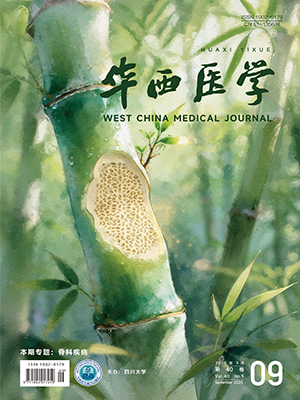| 1. |
CHINET 數據云. 細菌分類年份統計. [2024-02-06]. http://www.chinets.com/Data/GermYear.
|
| 2. |
Huang W, Qiao F, Zhang Y, et al. In-hospital medical costs of infections caused by carbapenem-resistant Klebsiella pneumoniae. Clin Infect Dis, 2018, 67(Suppl_2): S225-S230.
|
| 3. |
World Health Organization. Guidelines for the prevention and control of carbapenem-resistant Enterobacteriaceae, Acinetobacter baumannii and Pseudomonas aeruginosa in health care facilities. Geneva: World Health Organization, 2017.
|
| 4. |
肖桂榮, 宗志勇. 從《遏制微生物耐藥國家行動計劃(2022-2025 年)》談醫療機構抗微生物藥物管理與微生物耐藥防控. 華西醫學, 2023, 38(3): 321-325.
|
| 5. |
Campos-Madueno EI, Moradi M, Eddoubaji Y, et al. Intestinal colonization with multidrug-resistant Enterobacterales: screening, epidemiology, clinical impact, and strategies to decolonize carriers. Eur J Clin Microbiol Infect Dis, 2023, 42(3): 229-254.
|
| 6. |
Halaby T, Al Naiemi N, Beishuizen B, et al. Impact of single room design on the spread of multi-drug resistant bacteria in an intensive care unit. Antimicrob Resist Infect Control, 2017, 6: 117.
|
| 7. |
Janda JM, Abbott SL. The changing face of the family Enterobacteriaceae (Order: “Enterobacterales”): new members, taxonomic issues, geographic expansion, and new diseases and disease syndromes. Clin Microbiol Rev, 2021, 34(2): e00174-20.
|
| 8. |
Qiao F, Wei L, Feng Y, et al. Handwashing sink contamination and carbapenem-resistant Klebsiella Infection in the intensive care unit: a prospective multicenter study. Clin Infect Dis, 2020, 71(Suppl 4): S379-S385.
|
| 9. |
Kotsanas D, Wijesooriya WR, Korman TM, et al. “Down the drain”: carbapenem-resistant bacteria in intensive care unit patients and handwashing sinks. Med J Aust, 2013, 198(5): 267-269.
|
| 10. |
Valentin AS, Santos SD, Goube F, et al. A prospective multicentre surveillance study to investigate the risk associated with contaminated sinks in the intensive care unit. Clin Microbiol Infect, 2021, 27(9): 1347. e9-1347. e14.
|
| 11. |
Jamal AJ, Garcia-Jeldes F, Baqi M, et al. Infection prevention and control practices related to carbapenemase-producing Enterobacteriaceae (CPE) in acute-care hospitals in Ontario, Canada. Infect Control Hosp Epidemiol, 2019, 40(9): 1006-1012.
|
| 12. |
Gestrich SA, Jencson AL, Cadnum JL, et al. A multicenter investigation to characterize the risk for pathogen transmission from healthcare facility sinks. Infect Control Hosp Epidemiol, 2018, 39(12): 1467-1469.
|
| 13. |
Hota S, Hirji Z, Stockton K, et al. Outbreak of multidrug-resistant Pseudomonas aeruginosa colonization and infection secondary to imperfect intensive care unit room design. Infect Control Hosp Epidemiol, 2009, 30(1): 25-33.
|
| 14. |
國家衛生和計劃生育委員會規劃與信息司, 中國醫院協會醫院建筑系統研究分會. 綜合醫院建筑設計規范: GB 51039-2014. 北京: 中國計劃出版社, 2014.
|
| 15. |
重癥監護病房醫院感染預防與控制規范: WS/T 509-2016. 中國感染控制雜志, 2017, 16(2): 191-194.
|
| 16. |
Warnke P, Pappisch VR, Frickmann H, et al. Influence of bed making on loads of airborne and surface-associated drug-resistant bacteria in patient rooms. J Hosp Infect, 2023, 136: 45-54.
|
| 17. |
Nelson NM, Aceto A, West GF. New patient privacy curtains to provide passive infection prevention. Infect Prev Pract, 2023, 5(3): 100291.
|
| 18. |
Shek K, Patidar R, Kohja Z, et al. Rate of contamination of hospital privacy curtains on a burns and plastic surgery ward: a cross-sectional study. J Hosp Infect, 2017, 96(1): 54-58.
|
| 19. |
Gomides MDA, Fontes AMS, Silveira AOSM, et al. The importance of active surveillance of carbapenem-resistant Enterobacterales (CRE) in colonization rates in critically ill patients. PLoS One, 2022, 17(1): e0262554.
|
| 20. |
Guo B, Guo Z, Zhang H, et al. Prevalence and risk factors of carbapenem-resistant Enterobacterales positivity by active screening in intensive care units in the Henan Province of China: a multi-center cross-sectional study. Front Microbiol, 2022, 13: 894341.
|
| 21. |
Chen X, Wen X, Jiang Z, et al. Prevalence and factors associated with carbapenem-resistant Enterobacterales (CRE) infection among hematological malignancies patients with CRE intestinal colonization. Ann Clin Microbiol Antimicrob, 2023, 22(1): 3.
|
| 22. |
喬甫, 宗志勇. 世界衛生組織《醫療機構耐碳青霉烯的腸桿菌科細菌、銅綠假單胞菌和鮑曼不動桿菌防控指南》介紹. 華西醫學, 2018, 33(3): 259-263.
|
| 23. |
Reis MAO, de Almeida MCS, Escudero D, et al. Chlorhexidine gluconate bathing of adult patients in intensive care units in S?o Paulo, Brazil: impact on the incidence of healthcare-associated infection. Braz J Infect Dis, 2022, 26(1): 101666.
|
| 24. |
Abboud CS, de Souza EE, Zandonadi EC, et al. Carbapenem-resistant Enterobacteriaceae on a cardiac surgery intensive care unit: successful measures for infection control. J Hosp Infect, 2016, 94(1): 60-64.
|
| 25. |
Gall E, Long A, Hall KK. Chlorhexidine bathing strategies for multidrug-resistant organisms: a summary of recent evidence. J Patient Saf, 2020, 16(3S Suppl 1): S16-S22.
|
| 26. |
Lee JH, Shin J, Park SH, et al. Role of probiotics in preventing carbapenem-resistant Enterobacteriaceae colonization in the intensive care unit: risk factors and microbiome analysis study. Microorganisms, 2023, 11(12): 2970.
|
| 27. |
中華人民共和國國家衛生和計劃生育委員會. 醫療機構環境表面清潔與消毒管理規范 WS/T 512-2016. 中國感染控制雜志, 2017, 16(4): 388-392.
|
| 28. |
Liu HL, Liu YL, Sun FY, et al. Hand hygiene among anesthesiologists and microorganisms contamination in anesthesia environments: a single-center observational study. Biomed Environ Sci, 2022, 35(11): 992-1000.
|
| 29. |
Friedman ND, Carmeli Y, Walton AL, et al. Carbapenem-resistant Enterobacteriaceae: a strategic roadmap for infection control. Infect Control Hosp Epidemiol, 2017, 38(5): 580-594.
|
| 30. |
俞娟芬, 邢虎, 張德厚, 等. 多部門聯合干預對重癥監護病房多重耐藥菌感染管理的效果研究. 中國消毒學雜志, 2022, 39(1): 58-61.
|
| 31. |
余淑霞, 路寧維, 許婷, 等. 多部門協作聯合干預 ICU 耐碳青霉烯類鮑氏不動桿菌醫院感染聚集性病例的效果. 中華醫院感染學雜志, 2022, 32(10): 1581-1585.
|
| 32. |
林秀芳, 賴凌宇. 基于 MDT 與危急值管理在醫院多重耐藥菌醫院感染中的應用. 中國衛生標準管理, 2023, 14(13): 169-173.
|
| 33. |
莫元春, 李沃田, 楊文, 等. 危急值管理在多重耐藥菌感染控制中的應用. 中華醫院感染學雜志, 2019, 29(10): 1575-1578.
|




